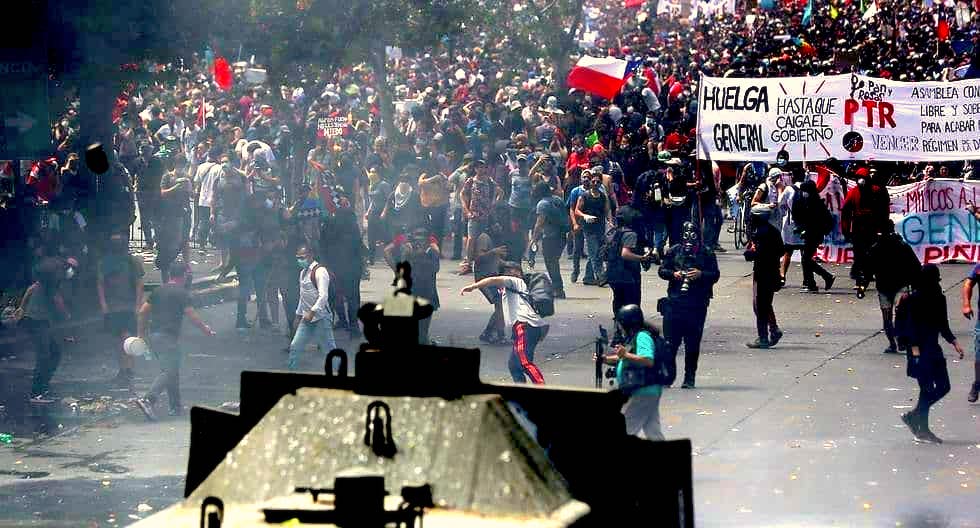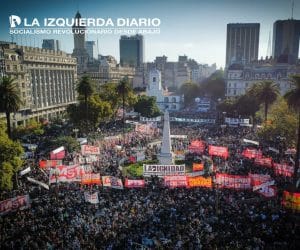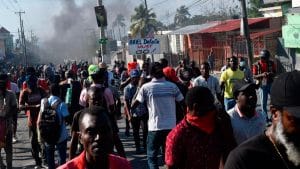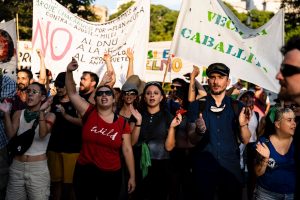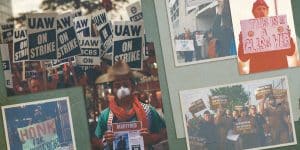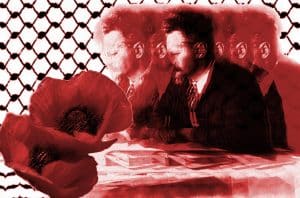It’s been a month since the outbreak of protests in Chile, and people are still in the streets, protesting, blocking traffic and fighting the cops. In the first phase of the uprising, spontaneity prevailed. Masses of students and young protesters took to the streets, set subway stations on fire and defied the curfew and the police. Then, in October 25, came the “largest mobilization in Chile’s history,” when 2 million people demonstrated in Santiago. Bourgeois politicians, including even President Sebastián Piñera, rushed to congratulate the protesters in an attempt to ride the wave and tame the movement, which seemed to have peaked. The military was still on the streets, and the curfew was still in force in several cities. The government announced it was taking the army out of the streets and proposed a “social agenda” to appease the people in revolt. The subway fare hike was rolled back, and Piñera announced a set of bills that included an increase in the minimum wage and pension benefits, and the commitment to address other issues such as access to health and medications, a repeal of the last increase in the price of electricity, an increase in taxes on the rich and other measures. Importantly, most of these were merely bills to be presented in Congress and, therefore, far from being implemented.
But the next week a broad “vanguard” of more resolute protesters continued in the streets. Once mobilized, emboldened by the power they felt when taking over the streets, shutting down transportation and defying the police, they didn’t stop at a handful of “economic demands”—there was much more that needed an urgent solution. Popular outrage mounted in response to the brutal repression of the first weeks of protests, which included the deployment of the military, the murder of at least 23 protesters, and the more than 100 people who lost an eye as a result of being shot with rubber bullets. The hatred of the masses for the government and its association with the Pinochet regime became a strong driving force behind the continuing mobilizations. The political demands, then, took a more central place: Primarily, the calls for Piñera to resign and the pressure to radically transform the regime inherited from Pinochet’s dictatorship—which includes extraordinarily weak unions, an anti-democratic political system and the extreme commodification of health care, education, pensions, and more. “Fuera Piñera” became the rallying cry of millions.
Most importantly, some of the largest unions in the country entered the political scene with calls for national strikes. This marks a second phase of the uprising in Chile. The dockworkers were at the forefront of this effort, and public sector workers and students joined the call. On Nov. 12, as Piñera entertained the idea of a new constitution, a second national/general strike, the largest strike since the Pinochet dictatorship, paralyzed the country and confirmed that without a more meaningful response from the government, the mobilizations were not going anywhere. The need for a radical reform of the regime inherited from Pinochet took center stage and became articulated by protesters in the call for a Constituent Assembly.
We need your support to continue the coverage of the uprising in Chile. Visit us on Patreon
Whereas in the first phase of the uprising there was little to no “leadership” steering the masses of angry protesters, in this second phase the leadership of unions, political parties and other organizations started to play their cards. Some of them turned their backs on the protests, like the transportation unions in Santiago and most miners’ and retail unions. Others called on their memberships to mobilize, but as a strategy to “strike and negotiate”—that is, using the leverage of “the street” only to force concessions from the government rather than pushing for the overthrow of Piñera. This, for example, has been the strategy of the CP-led Mesa de Unidad Social, a coalition that includes unions, retirees for the nationalization of the pension system (the no+afp collective), student unions and community organizations.
Now, since November 15, there has been a multiparty operation to “decompress” the situation with a “social peace pact” among the leaderships of different parties, including the governing coalition Chile Vamos, some parties of the former “concertación” (Socialist Party, for example—although, notably, not the CP), and the main parties in the Frente Amplio (FA, Broad Front). This agreement has set the date for a referendum on whether to reform the constitution for April 2020, keeping the constitutional reform process controlled and restrained through different anti-democratic mechanisms. For example, two-thirds of the vote will be needed to overturn any clause of the current constitution; the election of delegates will follow an undemocratic “slate” system; only those aged 18 or older can vote; union activists who hold positions in their unions cannot run.
What has been the role of the left?
The largest parties on the left have played an ambiguous role, celebrating and encouraging the protests, yet granting legitimacy to the government and state institutions. A few weeks ago, while protesters were challenging the curfew and fighting the cops and the military in the streets, Camila Vallejos and other CP lawmakers were in session in congress advancing a bill to increase the minimum wage. Now the “grand” agreement (“social peace pact”), reached on November 15 among Piñera and the leaders of the Socialist Party, the Frente Amplio, and all the parties of the regime, is an attempt to let off steam and, by doing so, save Piñera’s neck. The message is “If you want change, it has to be through institutional channels.”
What they don’t say—but everyone knows—is that an overthrow of Piñera through mass mobilizations would considerably weaken the regime, embolden the mobilized masses and encourage them to go for more. It opens a Pandora’s box, in which the recognition of all institutions, including the parties in congress as legitimate representatives of the people, would be put into question. But the parties of the left who signed on to this social pact are a bit uncomfortable, because the political cost for them is too high: It is nothing less than negotiating with a murderous government and effectively dropping the fight for ousting Piñera. The CP didn’t take part in the agreement, probably to save its reputation, but it has shown itself willing to participate in the negotiations for a better social pact, with the same participants. Most parties in the Frente Amplio, however, did sign the agreement, which immediately generated cracks inside one of the main parties: Jorge Sharp, mayor of Valparaiso (Chile’s second-largest city) and national leader of Convergencia Social, resigned from the organization in a letter signed by 72 other party leaders.
It is a sign or our times, and a testament to the incorporation of so-called Socialist and Communist parties into the capitalist state, that, in the face of a regime that allows for only cosmetic reforms, the parties that claim to represent the left and the working class pursue only a path of negotiations with the very abhorred actors at the helm of the regime, playing by their rules and on the terms imposed by a post-(semi) dictatorial regime. The narrow-mindedness of left political leaders who can envision a path for change only within the stale premises of congress, through slow and bureaucratic proceedings, can be explained only by an obstinate trust in their ability to seize the state apparatus and use it for a social (or even socialist) transformation from above. There are plenty of historical examples that show that this is a dead-end strategy, not least that of Allende’s government in Chile in the 1970s.
The need for a strong revolutionary left
There is a small example of revolutionary practice in Chile that is, today, taking the exact opposite approach: Members of the Partido de los Trabajadores Revolucionarios (Revolutionary Workers’ Party, PTR) are trying to develop the mobilizations to its maximum capacity. Not in a plainly disruptive, agitational way, but in an attempt to articulate the most radical elements in a working-class, socialist perspective; building organs of leadership, coordination and self-organization among the vanguard of protesters; and trying to link the movement of protesters to unions and students’ organizations.
The place where they have advanced the most in doing so is the northern port city of Antofagasta, where they led the efforts to build the Emergency and Protection Committee (Comité de Emergencia y Resguardo), with the teachers’ union taking the lead and providing the union’s local for meetings that gather hundreds of workers from education, health and other sectors, students and protesters in general. This committee undoubtedly became the hegemonic body leading the protests in Antofagasta, coordinating a mobilization in a united front with the local section of the CUT (labor federation of Chile) and other organizations that joined the call.
On a very small scale, this accomplishes the task of creating a workers’ united front and thereby providing the space for coordination and action independent of the state and bourgeois parties. It serves to channel all the discontent and the eagerness for change through working-class institutions. In this sense, it shows the strategic role of workers organized as a class: It’s an example of working-class hegemony.
A testament of the threat that this represents is the persecution by the government of union activist and PTR leader Dauno Tótoro. A former candidate for congress for Santiago’s District 10, the young history teacher has come into the crosshairs of the city’s general prosecutor, who has filed charges against him of “inciting violence” and “subversion of order.”
We need your support to continue the coverage of the uprising in Chile. Visit us on Patreon
The PTR is accompanying this with calls to action and interventions in the protests with the call for a political general strike until Piñera falls, and for a “Free and democratic Constituent Assembly!” They do so through the La Izquierda Diario website, which last month reached 2 million visits. The call for a Constituent Assembly is not an anti-capitalist demand per se, and the appropriateness of its use depends on the circumstance (there is a long history of debates around the Constituent Assembly in the communist movement since the Russian Revolution). In brief, the Constituent Assembly is one of many radical democratic demands that can help advance the movement and, at the same time, expose the unwillingness of government officials, bourgeois parties, reformists and their bureaucracies to accompany the will of the masses to the last consequences. A free, democratic Constituent Assembly—not the rigged “constitutional convention” proposed in the social pact—although still within the limits of a capitalist regime, can put “everything” into question and open a conversation among the broadest masses about distribution of resources, the extreme commodification of daily life, the protection of capitalist profits, the living conditions of the vast majority of the population, etc. This can provide an opening for the spread of socialist ideas among large sectors of society.
The social and political situation in Chile has already been radically transformed. Today, after more than a month of protests that challenge the law, the forces of repression and the leadership of all traditional (and some newer) parties, the horizon of what’s possible has expanded into new terrain. Demonstrations in the main cities continue unabated, with almost daily confrontations with the police, and a broad layer of the population has unequivocally rejected the social pact. The energy of the social explosion has not dissipated, and the left faces a fork in the road: One path is through congress and other institutions, involving dialogue with establishment parties and deference to the limits imposed by law and order. For those taking this path, the mobilizations serve as nothing more than pressure to negotiate on better terms. The alternative path is to foster the independent organization and action of the working class and its allies (students, Mapuche communities, middle-class sectors that resolutely want to bring down Piñera). This latter approach involves building bodies of self-organization and advancing independent, working-class politics with no compromises, with the purpose of developing as much as possible, in the concrete experience of struggle against the state, the revolutionary consciousness of the masses. The depth of the social crisis in Chile signals the opening of a long process, the critical point of which might be several years from now. There is no sizable revolutionary party right now in Chile—the situation would be radically different if this were the case. But the small yet important experiences of self-organization and united front that the PTR is leading can provide a solid foundation, not only for this episode of class struggle but also for those to come. The weapons that are forged in struggle today will be paramount when the decisive battle comes.


